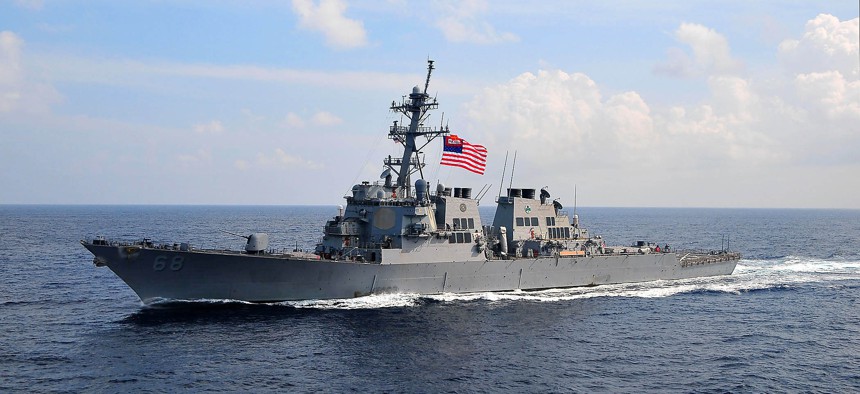Navy strengthens ship-based electronic warfare
The service is upgrading an electronic warfare sensor now on many guided missile cruisers and destroyers.
The service is now in the process of upgrading its existing SLQ-32 Surface Electronic Warfare Improvement Program, or SEWIP — an electronic warfare sensor now on many guided missile cruisers and destroyers.
SEWIP is designed to detect approaching threats, such as anti-ship cruise missiles, in time for ship commanders to take defensive or protective actions. It is configured to provide early detection, signal analysis and threat warnings against a range of threats.
While much of the work on SEWIP is being done by large defense firms such as Northrop Grumman, the Navy recently awarded a $7 million deal to Virginia-based NexGen for procurement of an element of SEWIP called AN/SSX-1 Specific Emitter Identification System.
The SLQ-32 is a little panel that looks like an old electronic TV set with panels on the front. Navy developers have explained that certain countries on the Eurasian land mass are building weapons that a SLQ-32 will not detect.
Cruisers and destroyers unable to recognize approaching threats will be unable to deploy defensive measures such as decoys, service officials said.
The Navy needs to upgrade electronic warfare technology faster on more of its surface ships because potential enemies are developing weapons designed to penetrate defensive systems on many U.S. cruisers and destroyers, service leaders said.
While Navy officials have not specified countries or provided details regarding these new weapons, they did say they were being engineered as multi-seeker weapons coming in at supersonic speed.
Following the initial current SEWIP Block 2 upgrade, the Navy plans to develop and acquire a Block 3 SEWIP electronic attack technology, Navy and industry officials said.
In addition to “listening” or passive electromagnetic detection, Block 3 will include the ability to transmit signals and potentially jam or disrupt enemy signals.
Last year, Northrop was awarded a $267 million deal to build SEWIP Block 3. The Navy is now making substantial progress with SEWIP Block 3.
Ship-based electronic warfare is designed to detect electromagnetic signals from potential adversaries and provide counter-targeting and counter-surveillance technology. For example, the receiver, antenna and software built into the SEWIP system would help detect the presence of an incoming enemy missile, enemy radar or radio activity and aircraft or a surface vessel.
The Navy has already configured an Arleigh Burke-class guided missile destroyer, the USS Bainbridge, with what’s called Block 2 of its SLQ-32 SEWIP. However, many more upgraded systems are needed if surface ships are going to stay ahead of weaponry being developed by potential adversaries, service officials said.
Upgraded SEWIPs were being acquired for many of the Navy’s forward-positioned ships in strategic locations such as Japan and Rota, Spain, according to the Navy.
The Block 2 SEWIP advancements include upgrades to the antenna and digital receiver. Block 2 upgrades also include the addition of new software engineered to ensure the system is equipped to recognize new, emerging threat signals.
The Navy plans to configure as many as 140 surface ships with Block 2 SEWIP technology, including carriers, cruisers, destroyers and amphibious assault ships, among others.
The hardware to the system consists of above and below deck components including a display screen and processing technology, officials said.
The hardware may be configured differently depending upon the structure of a given ship, developers said. For example, the EW antenna on the Navy’s new destroyer, the DDG 1000, is conformed to align with the ship’s hull.
NEXT STORY: Quantum leaps needed for new computer approach




